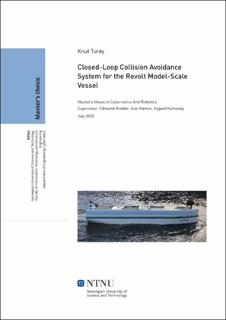| dc.contributor.advisor | Brekke, Edmund | |
| dc.contributor.advisor | Hamre, Geir | |
| dc.contributor.advisor | Kamsvåg, Vegard | |
| dc.contributor.author | Turøy, Knut | |
| dc.date.accessioned | 2021-09-23T18:19:59Z | |
| dc.date.available | 2021-09-23T18:19:59Z | |
| dc.date.issued | 2020 | |
| dc.identifier | no.ntnu:inspera:56990118:20983095 | |
| dc.identifier.uri | https://hdl.handle.net/11250/2780995 | |
| dc.description.abstract | I denne oppgaven har et antikollisjons-system i lukke sløyfe basert på scenariobasert modellprediktive regulator blitt utviklet og testet for autonome overflatefartøy ved å bruke 1:20 modellskalabåten ReVolt. Antikollisjons-system er vesentlig for å utføre robuste, trygge og forutsigbare avgjørelser som samsvarer med de internasjonale forskriftene for forebygging av kollisjon på sjøen (COLREGS).
Antikollisjonssystem kan velge mellom å bruke et integrert probabilistisk datassosiasjonsfilter(IPDA), kamera og LiDAR-sensorfusjonssystem, eller et automatisk identifikasjon-ssystem (AIS) trackingsystem basert på et modifisert versjon av Kalmanfilter. Prediksjonen av trajektoren til eget skip i SBMPCen har blitt forbedret ved å ta hensyn til tidsvarierende headingreferanser, en lookahead-distanse som er avhengig av cross-track-error, samt muligheten til endre endre kursreferanse underveis i prediksjonshorisonten. Dessuten har et nytt sensorsystem blitt satt opp p ̊a ReVolt i samarbeid med ansatte i DNV GL, og en kamera-LiDAR-kalibrering har blitt utført.
Antikollisjonsmetoden, sammen med AIS trackingsystemet, har blitt implementert og testet i en rekke sanntidssimuleringer. Resultatene viser at det SBMPC-baserte antikollisjonssystemet klarer å unngå dynamiske hindringer i samsvar med COLREGS i alle utførte scenarier. Videre viste det seg at å endre kursreferanse iløpet av prediksjonshorisonten effektiviserte unnamanøvrene i tillegg til å gjøre unnamanøvrene merforutsigbare for andre fartøy. Det ble utført sjøeksperiment med ReVolt, som brukte IPDA LiDAR-tracking,for å verifiserte oppførselen til antikollisjonsmetoden. Resultatene viser lovende sanntidsegenskaper, der hindringen ble unngått i alle utførte kollisjonsscenarier. Unnamanøvrene led av treg respons grunnet lav bånnbredde på manøvreringsregulatorene.Trackingresultatene ble verifisert av GNSS-data og viste konsistente og nøyaktige estimater. | |
| dc.description.abstract | In this thesis, a closed-loop collision avoidance system (CAS) based on the scenario-based model predictive control (SBMPC) is developed and tested for autonomous surface vessels (ASVs) using the 1:20 scale model ReVolt. The CAS is of great importance to make robust, safe, and predictable decisions in compliance with the international regulations for preventing collisions at sea (COLREGS) for ASVs.
The CAS has the ability to use either an integrated probabilistic data association (IPDA) camera-LiDAR sensor fusion system,or an automatic identification system (AIS) tracking system based of the missing measurement Kalman filter (MMKF). Prediction of the own ship trajectory in the SBMPC has been improved by considering time-varying heading reference, a cross-track error dependent lookahead distance, and the ability to change course during the prediction horizon. Furthermore, an improved sensor setup on ReVolt has been employed by moving the LiDAR, and a camera-LiDAR calibration has been performed.The collision avoidance (COLAV) method, with the AIS tracking system, hasbeen implemented and tested in a variety of real-time simulations. The results show that the SBMPC CAS can avoid the obstacles in compliance with COLREGS in all performed scenarios. Furthermore, the use of change points improved the efficiency of the evasive maneuvers as well as making the maneuvers more predictable to other vessels.
Real-life experiments with ReVolt using IPDA LiDAR tracking is then performed to verify the behavior of the COLAV method. The results show promising real-time capabilities, successfully avoiding the obstacle in all scenarios. The evasive maneuvers suffered from slow response due to the low bandwidth of the maneuvering controllers. The tracking results were verified by ground truth data and showed consistent and accurate estimates. The verification of the camera-LiDAR sensor fusion system remains as future work. | |
| dc.language | | |
| dc.publisher | NTNU | |
| dc.title | Closed-Loop Collision Avoidance System for the Revolt Model-Scale Vessel | |
| dc.type | Master thesis | |
